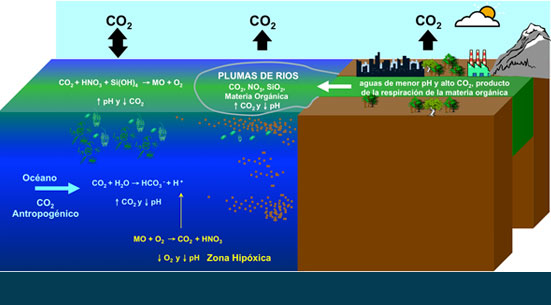Increasing atmospheric CO2 has lowered the pH of the surface ocean, and although the ocean has partially absorbed anthropogenic atmospheric CO2, this has come at the expense of a significant reduction in pH and carbonate ion concentration, a process known as Ocean Acidification (OA).
Many coastal ecosystems may experience significantly higher levels of pCO2 in seawater than expected due to equilibrium with the atmosphere, levels linked to biological processes and/or the impact of two important processes; river plumes and coastal upwelling events, processes that interact in a very dynamic way on continental shelves. In coastal upwelling areas, deep waters with high pCO2 content rising to the surface result in lower pH in coastal areas.
Another significant process that affects carbon chemistry is the discharge of acidic water from rivers. River discharges are acidic compared to ocean waters, primarily due to the combination of low alkalinity and high dissolved inorganic carbon (DIC) and pCO2 that originates from respiration of anthropogenic and natural organic matter.
Finally, estuarine environments elsewhere are generally characterized by acidic brackish water with high pCO2 content. Therefore, the questions we want to answer are:
What is the spatial and seasonal variability of carbonate chemistry at critical OA sites, including estuaries, river plumes, and/or upwelling areas?
What is the impact of low pH and high DIC (river and upwelling) waters and secular OA (anthropogenic) for coastal phytoplankton in regions of high coastal production?
Our methodological approach will consider the analysis of physico-chemical variables, including a detailed estimation of the CO2 system and isotope analyzes of the DIC pool (δ13C-DIC), as well as measurements of biological variables and experimentation and community respiration during contrasting scenarios (winter vs summer). Furthermore, to assess the impact of future OA scenarios on different phytoplankton communities, our methodological approach also involves the use of CO2 mesocosms to manipulate conditions of pH, DIC, and pCO2, and to assess the impact of OA on primary production, elemental stoichiometry and community structure.

